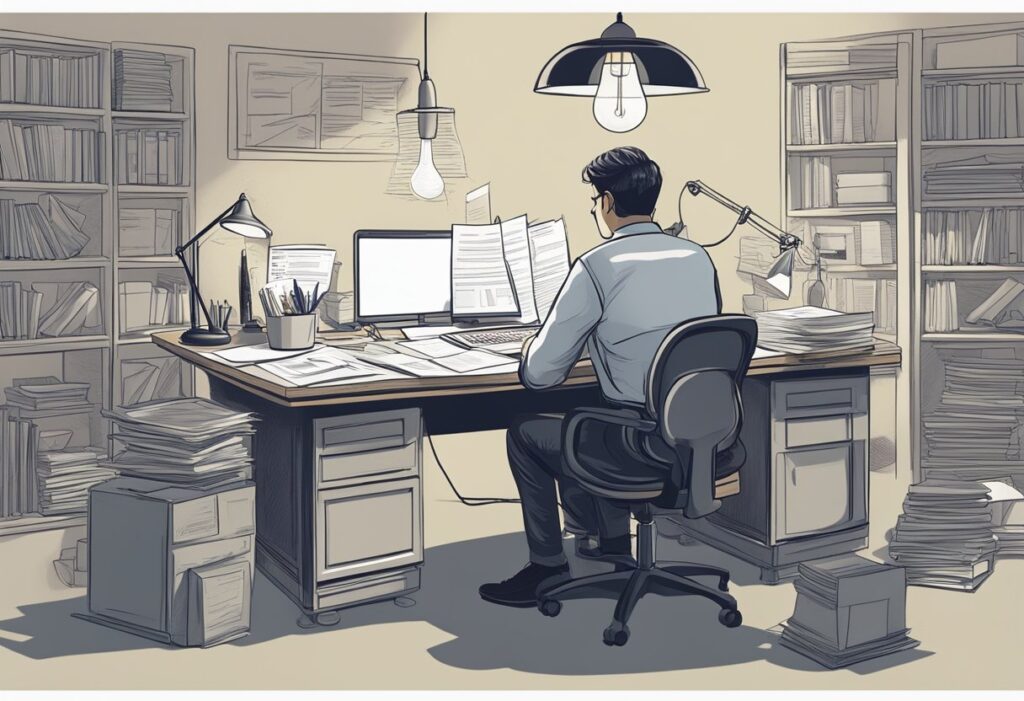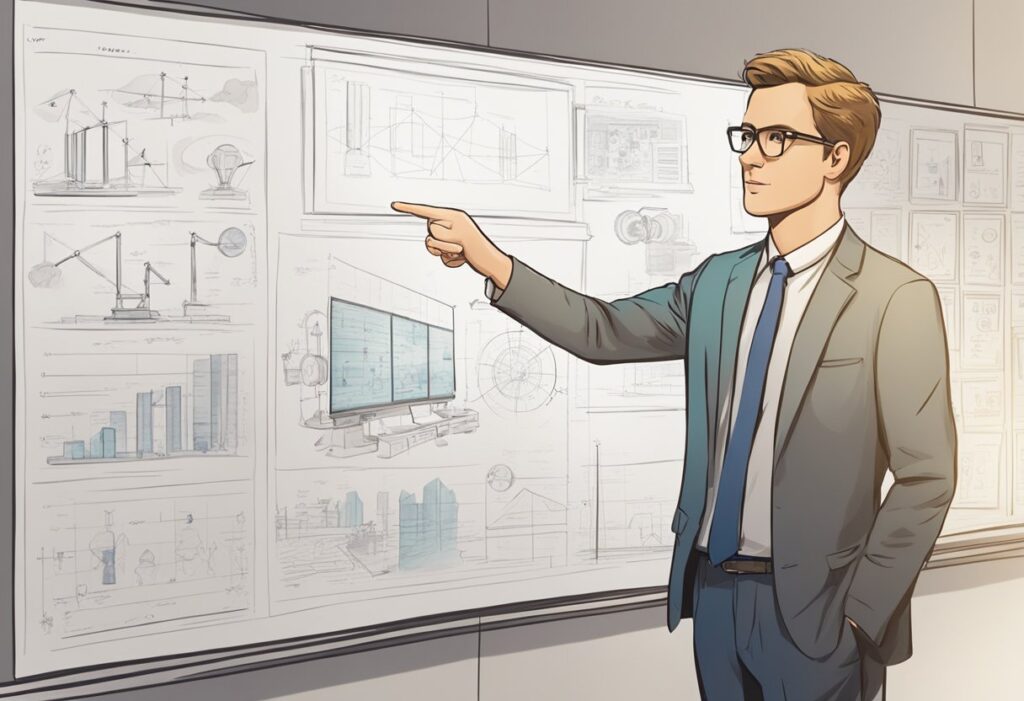Originally posted on February 13, 2024 @ 9:52 am
Kicking off the adventure of turning a **bright idea** into something to sell is thrilling, like a rollercoaster ride. But it can feel like a bummer when money runs dry. Many people have strutted down this path, brimming with awesome ideas but lacking the cash to make them shine. Don’t throw in the towel just yet! The world brims with stories of smart folks starting from scratch and crafting their own success tales. Get the scoop on dodging financial pitfalls right from the start. Learn ways to ensure your invention is genuine and protect it from copycats, along with crafting a plan to share your creation with the world. **This is a treasure** for anyone eager to bring their dream to life, even when the wallet’s looking slim. Keep reading to learn how to flip the no-money blues on their head.
While the absence of funds can seem like a significant roadblock, it also compels us to be resourceful and strategic in our approach. In the early phase, it’s crucial to validate the viability of your idea to ensure it solves a real problem and has a potential market. This validation forms the cornerstone of any successful invention, paving the way for protection strategies like patents or trade secrets, which safeguard your concept from competitors. Thereafter, developing a prototype can often be achieved through alternative funding sources, collaborations, or frugal innovation techniques. As we progress, we focus on planning, financing strategies, building compelling presentations, and pitches that can attract investors or partners who share our vision, ultimately leading to marketing, licensing, or launching our invention effectively.
Key Takeaways
- Validating the invention idea ensures it addresses a real problem and has market potential.
- Protecting the invention can include patents or trade secrets even with limited resources.
- Strategic planning and leveraging various financing options are crucial for development and launch.
Validating Your Invention Idea

Before investing time and resources into an invention idea, it’s essential to determine its potential success in the marketplace.
Conducting Market Research
We begin by gathering data to understand the market’s needs and preferences. This involves analyzing existing products, assessing customer satisfaction, and identifying gaps that our invention could fill. We use surveys and study market trends to collect robust data that informs our decision-making process. Market research helps in understanding the competition and setting a foundation for a unique value proposition.
Identifying the Target Market
After conducting the initial market research, we need to clearly define our target market. This is the group of consumers who are most likely to benefit from and purchase our invention. Identifying our target market involves looking at demographic, geographic, and psychographic characteristics. We use this information to tailor our invention to meet the specific needs and desires of our intended audience.
Conducting a Prior Art Search
Finally, a thorough patent search is critical to ensuring our invention is truly original. We excavate existing patents and published applications to ascertain whether our idea or something similar has already been patented. This step is vital in determining the novelty of our invention, which is a prerequisite for patentability. Understanding the landscape of prior inventions can also inspire improvements and iterations to our initial concept.
By meticulously following these steps, we lay a strong foundation for the successful development and potential commercialization of our invention idea.
Protecting Your Invention
When you have an invention idea but no funds, protecting your intellectual property is a critical first step to ensure that your creation remains yours. We’ll walk through the essentials of solidifying your rights through understanding intellectual property, filing a provisional patent, and seeking legal advice.
Understanding Intellectual Property
Intellectual property (IP) encompasses the legal rights that come from the intellectual activity in the industrial, scientific, literary, and artistic fields. For us inventors, securing IP through a patent is imperative; it grants us exclusive rights to our inventions. There are different types of patents, including utility patents, which cover new processes or machines, and design patents, which protect the unique appearance of a product.
Filing a Provisional Patent
Filing a provisional patent is a cost-effective way to initially safeguard your invention. This allows us to establish an early filing date and gives us a year to refine our idea or seek funding. It’s a legal document that describes the invention and it does not require formal patent claims. Nevertheless, it must contain enough detail to fully disclose your invention.
Seeking Legal Advice
Consulting with a patent attorney can be a crucial step. They provide professional legal assistance in filing a patent that correctly and broadly covers the invention to prevent others from making, using, or selling the idea. Attorneys can also advise us on the complexities of intellectual property law, including any required trademark protections for branding associated with our invention.
By focusing on these key areas, we position ourselves to protect our intellectual property effectively, even when we start with no money.
Developing a Prototype
When we approach developing a prototype with limited resources, it’s essential to understand the fundamental steps of creation and testing. We focus on maximizing efficiency of design and resource allocation to transform an invention idea into a tangible model.
Creating Initial Drawings and Models
We initiate the prototype development by creating comprehensive initial drawings that outline the concept’s dimensions, aesthetics, and functions. This is where we employ Computer-Aided Design (CAD) software, which allows us to produce precise and modifiable schematics. Afterward, we create simple models, which can be physical or digital, to evaluate the idea’s feasibility and make any necessary adjustments early in the design phase.
Selecting Materials and Design
Choosing the right materials is crucial for both functionality and cost-effectiveness. We assess materials based on their durability, weight, cost, and suitability for the product’s intended use. It’s a balance between the ideal and the practical, focusing on what is available and what fits within our budget constraints. During this phase, we also refine the product design to optimize for the production process, keeping in mind both form and function of the prototype.
Building and Testing
With a clear design and materials selected, we move to construct a working prototype. Building the prototype gives us our first real glimpse into how the product will function in reality. We perform rigorous testing to identify any operational issues or areas for improvement, iterating on the design as necessary. It’s a hands-on process, where we measure the prototype’s performance against our initial objectives, ensuring that it meets all the planned specifications and functions as intended.
By following these structured steps, we lay the groundwork for efficiently turning our invention ideas into a viable prototype, ready for further development and eventual production.
Planning and Financing

Developing a successful invention hinges on careful planning and securing the right financing. We must precisely outline our strategy and accurately estimate costs to ensure our ideas become tangible, market-ready products. Let’s explore how we can navigate the financial landscape effectively.
Outlining Your Business Plan
- Executive Summary: A snappy overview of our business concept.
- Market Analysis: Detailed research on our target market and competitors.
- Product Description: What makes our invention unique and valuable.
- Marketing and Sales Strategies: How we plan to promote and sell our product.
- Financial Projections: An estimation of our financial future and break-even analysis.
Creating a comprehensive business plan is the foundation upon which our financial strategy is built. This plan is a crucial tool for communicating our vision to potential investors and financial institutions.
Estimating Costs and Budgeting
Startup Expense Estimates:
- Research and Development (R&D)
- Prototyping and Testing
- Legal Fees (patents, business registration)
- Marketing and Launch Costs
A meticulous budget that tracks every expense against our financial situation is essential. By estimating all startup costs, we can develop a solid budget that outlines how much money we need to raise to give our invention life.
Exploring Funding Options
Potential Funding Avenues:
- Self-funding: Utilizing our personal savings.
- Angel Investors: High-net-worth individuals interested in early-stage companies.
- Venture Capitalists: Firms providing large sums for significant growth potential.
- Business Loans: Traditional bank loans or SBA loans.
- Grants: Non-repayable funds from governments or private institutions.
- Family and Friends: Individuals from our personal network.
Exploring funding options entails understanding their implications for our business and financial autonomy. Angel investors and venture capitalists, for instance, might offer essential capital in exchange for equity. Alternatively, grants and business loans could provide funding without diluting ownership, but usually require a solid business plan and clear budgeting.
Building a Presentation and Pitch

When we have an invention idea but no funding, it’s crucial to create a persuasive pitch and presentation that will attract potential investors and partners. We must communicate our vision effectively to secure the support we need.
Crafting Your Pitch
To craft a winning pitch, we start by defining the problem our invention solves and explain how our idea is the solution. We ensure that our pitch is concise and captivating, aiming to spark the interest of potential investors such as angel investors or venture capitalists. We can use stories or scenarios to illustrate the value of our invention, making it relatable and compelling.
Developing a Compelling Presentation
Our presentation builds on the pitch by providing more depth. We use clear, engaging visuals and limit text to key points. Statistics, graphs, and images illustrate our market research and the potential growth of our idea. Testimonials or prototypes can help demonstrate the invention’s impact, making the opportunity tangible for investors.
Networking with Potential Investors and Partners
Networking is about connecting with the right people at the right time. We identify and attend industry events, pitch competitions, and meetups where we’re likely to encounter potential investors and partners. We approach networking systematically, setting specific goals for each interaction, whether it’s a face-to-face meeting or a virtual connection. Building strong relationships could lead us to the perfect partner or investor to help sell our idea.
Marketing and Licensing Strategies
When transitioning from an invention idea to a viable product, it’s crucial to develop a robust marketing plan and understand licensing agreements. Equally important is exploring various distribution channels to maximize your invention’s reach and profitability.
Establishing a Marketing Plan
We must first identify our target market and value proposition to create an effective marketing plan. By analyzing the marketplace, we can tailor our marketing strategies to the audience that shows the most potential interest in our invention. Setting clear objectives and defining our budget are necessary steps to remain focused and efficient. We then choose the right marketing mix, which may include online and offline advertising, public relations, and attending industry events to showcase our invention.
Understanding Licensing Agreements
Licensing can be a strategic move for us if we have an invention but lack the capital to manufacture and market it. By granting a licensee the rights to produce and sell our invention, we can receive royalties without the burden of production costs. It’s essential to thoroughly negotiate the terms of the licensing agreement, ensuring we secure our intellectual property and negotiate a fair percentage of net sales. Perusing successful licensing strategies can guide us in structuring our own agreements effectively.
Exploring Distribution Channels
Choosing the right distribution channels is pivotal for our invention’s success. We should consider both traditional avenues, such as retail partnerships and direct sales, and modern platforms like e-commerce. Each channel has its strengths and requires different approaches, so it’s important we align our choices with our marketing plan and target customer. Understanding the intricacies of various channels will help us determine the most advantageous path for our product to reach the consumer.
Launching Your Invention
Before diving into the process of bringing an invention to life, it’s essential to understand the steps involved in taking it from a mere concept to a market-ready product. We’ll navigate through the critical stages of manufacturing, developing the product line, and successfully entering the market.
Manufacturing Your Product
To begin manufacturing our invention, we must first ensure that the design is finalized and ready for production. This means having detailed specifications and possibly a prototype that showcases the functionality of our invention. Identifying the right manufacturer is crucial, as this will affect both the quality and the cost of producing our product. We can consider various manufacturing options, such as domestic or overseas production, based on what best fits our budget and quality requirements.
Developing Your Product Line
Once the manufacturing process is set up, the next step is product line development. This involves expanding our product offering to include different variations or additional features that could attract a broader customer base. It’s also the stage where we solidify our brand identity and position our product within the market. We need to focus on packaging, branding, and the added value we can offer to make our product stand out among competitors.
Entering the Market
Entering the market requires a strategic approach to ensure our invention captures attention and generates sales. This means we should be clear about our target audience, the channels we’ll use to reach them, such as online platforms, retail distribution, or direct sales, and how we’ll position our product in terms of pricing and marketing. Building awareness through marketing campaigns and leveraging social proof, such as testimonials or reviews, can be pivotal in gaining traction within the market.
Leveraging Your Success
When we’ve transformed our invention idea into a potential market hit but lack the funds to push forward, we must consider creative financial strategies. Our aim is to secure the capital needed to expand and profit from our innovation.
Seeking Partnerships and Expansion Opportunities
As we explore growth opportunities, forming partnerships with established businesses can be a mutually beneficial approach. Our business plan serves as a roadmap and persuades potential partners to invest. In securing a partnership, we leverage their resources to make money, while offering them a share in our success. It’s crucial to identify companies that align with our invention’s market and propose how the partnership can add value to their current offerings.
Negotiating Royalties and Selling Your Patent
In another strategy, we can negotiate royalties with a licensee, enabling us to earn revenue without directly manufacturing or marketing the product. Royalty agreements vary, so we must carefully structure terms to ensure a steady income stream. Alternatively, we have the option to sell our patent outright. This gives the buyer complete control over the invention, while providing us with a lump sum. We must assess the long-term potential of our invention against the immediate financial gain of a sale, aiming to strike a deal that reflects the true worth of our innovation.
Additional Resources
Navigating the landscape of invention development, particularly when funds are scarce, can feel daunting. We will explore credible online platforms and tools, as well as invention grants and competitions, which can be essential for taking your idea from concept to reality without a substantial personal financial investment.
Utilizing Online Platforms and Tools
Websites such as Google Patents allow us to search for existing patents, ensuring that our invention is unique and avoiding infringement on existing intellectual property. By understanding what’s already out there, we can tailor our ideas to be innovative and patentable. Additionally, platforms like Sharper Image or 3M often scout for new ideas and innovations, and submitting our inventions to such companies can sometimes lead to lucrative partnerships.
For a more comprehensive guide, visiting blogs that focus on innovation and invention can be insightful. These blogs may offer step-by-step guides on patenting processes or even on developing a brand around our invention.
Finding Invention Grants and Competitions
Our search for funding does not end at loans and personal financing. Invention grants, such as those offered by Dorman Products, Inc., can provide us with the necessary capital to develop our inventions without the need to repay. These grants are often competitive, so it’s crucial we present a robust case for our invention’s potential.
Similarly, competitions can offer not just monetary awards but also invaluable exposure. By participating in invention competitions, we not only have the chance to win funds but may also attract the attention of investors and companies interested in our work. It’s important for us to research and enter relevant contests where our invention meets the criteria.





